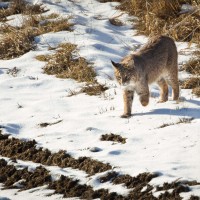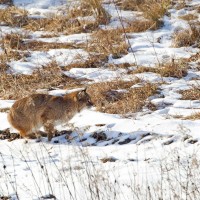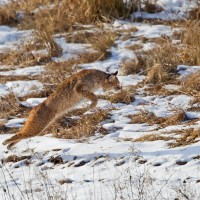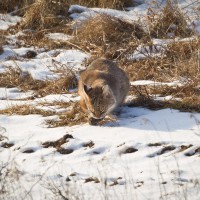Nature Photographer Melissa Groo Shares the “Spirit and the Essence” of this Surviving Bobcat
Melissa Groo, a nature photographer and story teller, visits places “on the edge of wildness, sits quietly and observes.” She was rewarded on this day, capturing the “spirit and essence” of this bobcat. You can follow this sequence of events, and get a glimpse into the biology and behavior of this wild cat, a master of survival. Here is Melissa’s story:
Bobcat Image #1 of 7. (above)
I was driving along a rural road in NE Pennsylvania, and saw what I at first thought was a housecat sitting out in a field. I took a closer look and noticed its ear tufts, and realized it was a bobcat. I sat and watched it as it got up and I realized that it only had half a front leg. It was undisturbed by my presence (in my car), and it began to stalk prey. Suddenly it leaped up into the air with a spectacular arc, and landed on its catch. It ate what looked like a vole, on the spot. It then walked away slowly, intent on its next catch. It was obvious that its injury had healed over, and that it had adapted to life with this handicap. I was inspired by its resilience, will to live, and remarkable agility. One of the few lucky ones.
© Melissa Groo Photography/All Rights Reserved 2014
www.melissagroo.com, www.facebook.com/melissa.groo
BOBCAT Image #2 of 7.
“Like most wild felines, bobcats are not capable of extended chases, so they must get close to their prey, without being seen, before launching their attack. Their spotted coats provide excellent camouflage against vegetation or the ground. Such camouflage is especially effective in the dappled light of the forest. For small cats such as the bobcat, and for the young of all species, camouflage also protects against larger predators. Variations in the bobcat’s pelage occur throughout its range. Northwestern populations seem to have more colorful coats and more distinctive spots than eastern or southern bobcats.” “Bobcat: Master of Survival” by Kevin Hansen
*Bobcat trapping season in Wyoming is November 15-March 1. There are no quotas. Any trapper can take an unlimited number of bobcats.
BOBCAT Image #3 of 7.
“Bobcats are stalking and ambush predators. Like most cats, with the notable exception of cheetahs, they attempt to catch their prey unaware rather than chase it down. They are master hunters that employ patience, speed, and precision rather than brute force. The cat is silent on approach, quick on the attack, and efficient in making the kill. “ “Bobcat: Master of Survival” by Kevin Hansen
*Steel leg-hold and padded-jaw traps baited with a scent attractive to bobcats or other predators are used. Animals are usually killed with a blow to the head or shot. Steel leg-hold traps are banned on public lands in some states.
*Bobcat paws, when caught in leg-hold traps, can freeze if wind chill dips to -10F or below. ”Typical foot hold traps and snares often produce some level of complete or partial restriction of blood flow to the limb distal to the mechanism and/or damage at some level to the tissues at the gripping point. Adding extreme hypothermic conditions would presumably make the situation worse.” Winston Vickers, DVM, MPVM, Associate Veterinarian, Wildlife Health Center, UC Davis
It is highly likely that a leg-hold trap or snare was the cause of the loss of the bobcat’s foot.
BOBCAT Image #4 of 7.
“Sharp claws are important for seizing and controlling prey so that the killing bite can be delivered. To keep their claws sharp, bobcats have spring-like ligaments that keep the claws retracted inside fleshy sheaths and elevated above the ground most of the time. Retraction of the claws is passive, requiring no conscious effort on the part of the cat. In use, the muscles in the forelegs contract, which in turn protracts the claws, and the bobcat is ready for action .” “Bobcat: Master of Survival” by Kevin Hansen
*Bobcat trappers are required to present their pelts for mandatory tagging in accordance with the Convention on International Trade in Endangered Species (CITIES). Although bobcats should be protected under international laws such as CITIES, loopholes, exemptions and lax enforcement have allowed a huge international market for trading bobcat fur.
*Wyoming bobcats are commercialized. The 2013/2014 harvest numbers are not being released to the public until June 1, 2014 by Wyoming Game and Fish Department.
Our bobcat reported harvest has been:
2007=3036
2008=2978
2009=1609
2010=1606
2011=1875
2012=1872
BOBCAT #5 of 7.
“When bobcats are foraging for mice or voles in long grass, an extended stalking approach is not possible. Here the wild cat employs a brief stalk followed by a high, curved jump, similar to what a fox uses to catch a mouse. Such an approach allows the bobcat to pounce directly on its prey, trapping the animal against the ground with its forepaws.” “Bobcat: Master of Survival” by Kevin Hansen
*Persons possessing a valid furbearing animal trapping license may use dogs to take bobcats during the bobcat hunting or trapping season.
BOBCAT Image #6 of 7.
“Once the rodent, hare, or rabbit is seized and pinned with the bobcat’s forepaws and claws, it is usually killed with a bite to the nape of the neck or head. The nape bite is faster if the feline’s teeth can penetrate the prey’s skull or sever the spinal cord.”
*How many bobcats are out there? “Wildlife managers have long used total annual harvest estimates of an animal as a reflection of its population levels. Although this may be valid for many game species, some biologists think it may not work for bobcats, or for other furbearers, for a variety of reasons. First, annual harvest estimates will reflect changes in population levels only if harvest pressure is relatively constant. Second, furbearer harvest levels are often directly related to pelt prices. Third, some furbearer harvest declines may occur only after repeated overharvests. And fourth, harvests may also be influenced by factors such as weather conditions during the fur harvest season.” “Bobcat: Master of Survival” by Kevin Hansen
BOBCAT image #7 of 7.
“ If a bobcat is stalking or walking on snow or on a muddy surface, its track sequences shows a direct register of tracks. This means that the rear feet are placed almost directly in the corresponding impression of the front feet. If it is walking normally, an overstepped register or slight offset direct register occurs. The rear feet are placed on top of or forward of the front feet impressions. The normal walking gait has a stride length ranging from 28 to 58.4 cm (11 to 23 inches) and a trail width from 7.6 to 13.6 cm (3 to 5 3/8 inches).” “Bobcat: Master of Survival” by Kevin Hansen
*This bobcat has survived to adapt to its own unique track. May it continue to live wild, free, and untrapped.
Thank you Melissa for sharing this sequence of bobcat images as we raise awareness of our Wyoming wild bobcats which are hunted and trapped without quotas.
© Melissa Groo Photography/All Rights Reserved 2014
www.melissagroo.com, www.facebook.com/melissa.groo









Are Harvest Mice Endangered – Jump From One Place to Another
[…] Download Image More @ wyominguntrapped.org […]